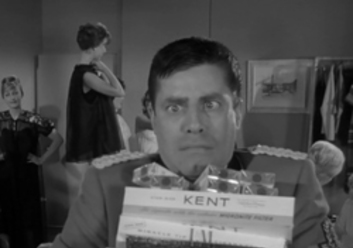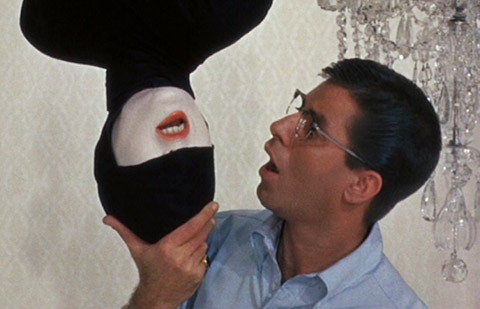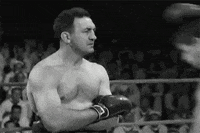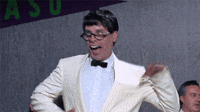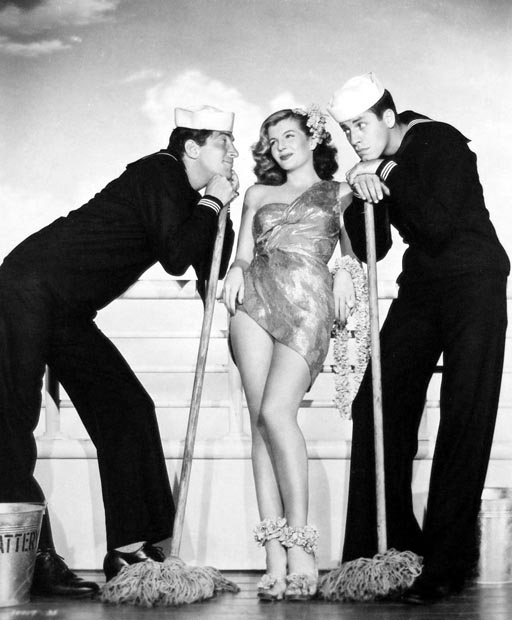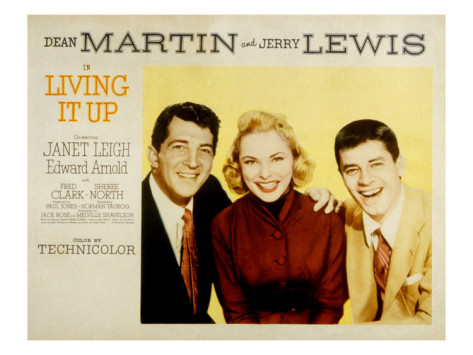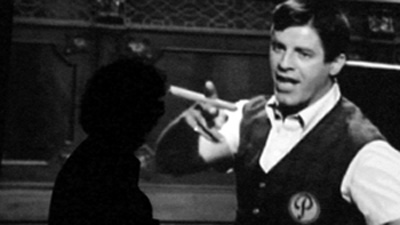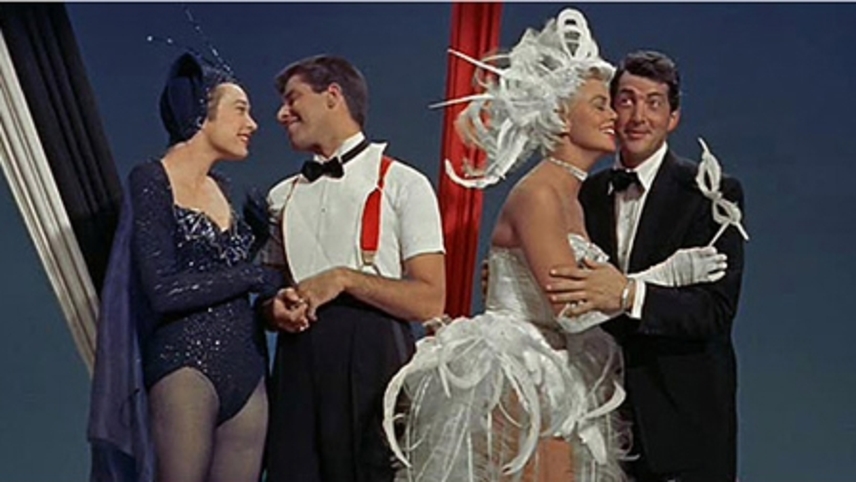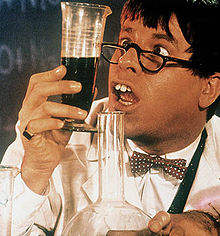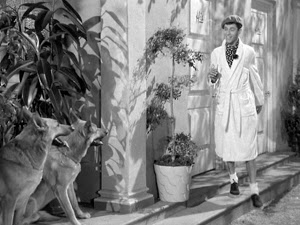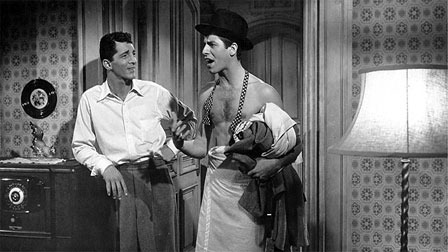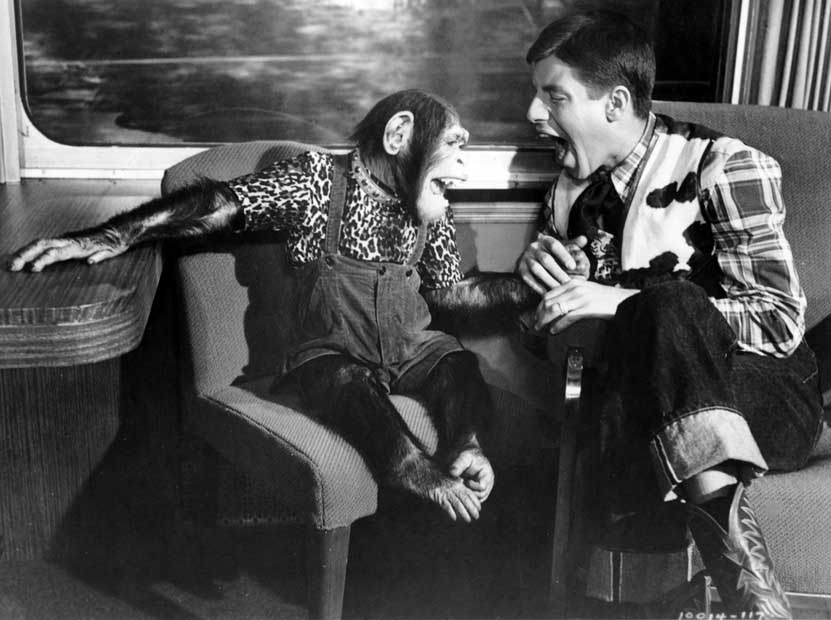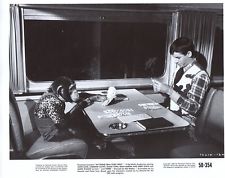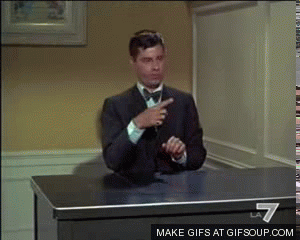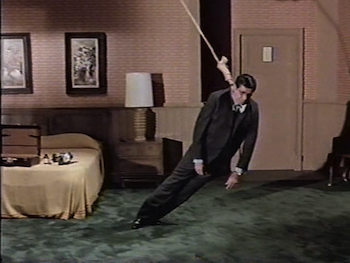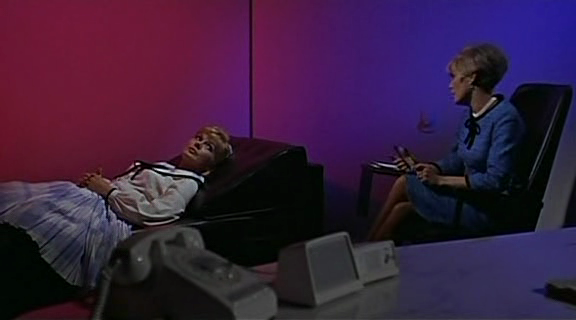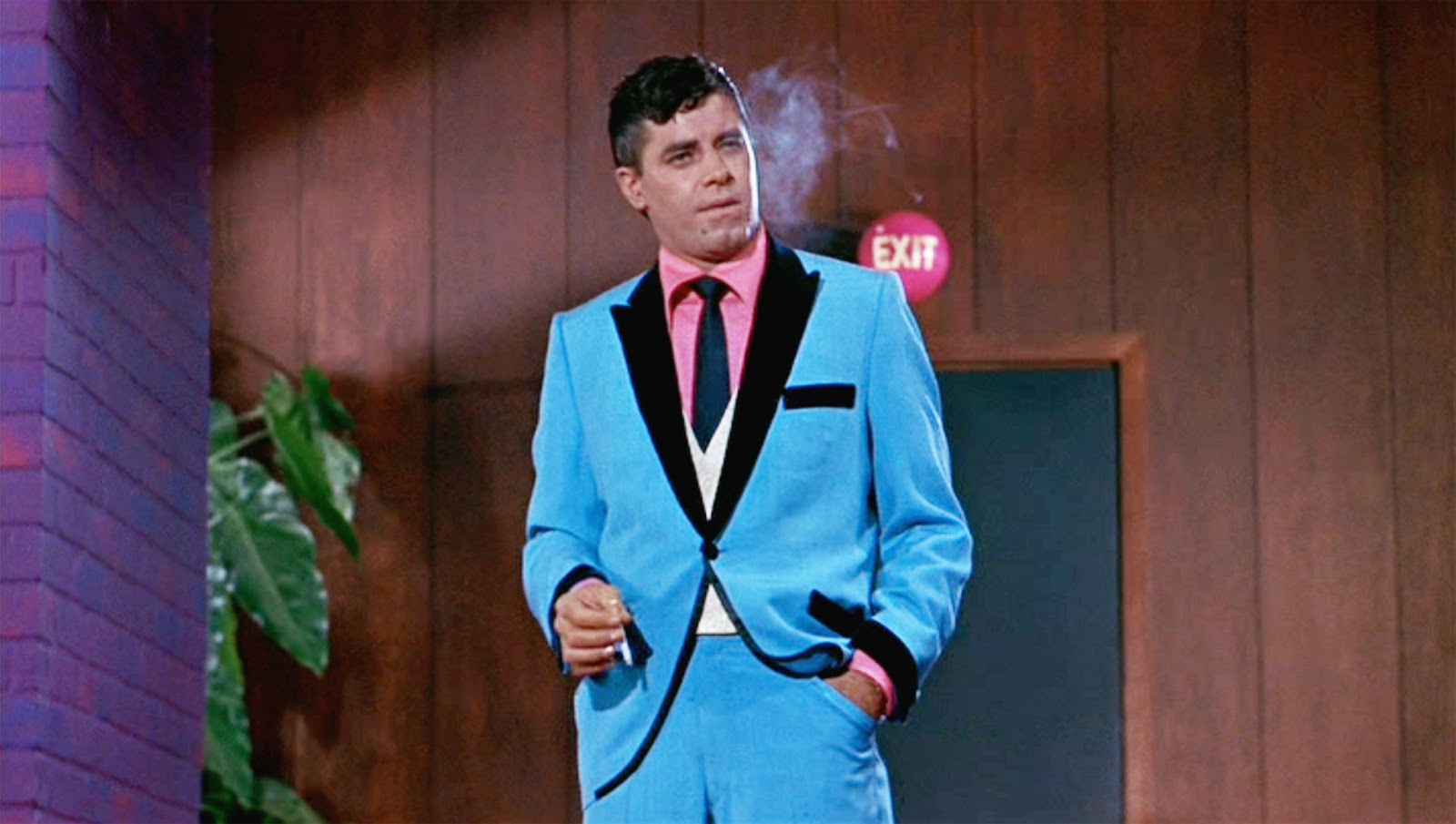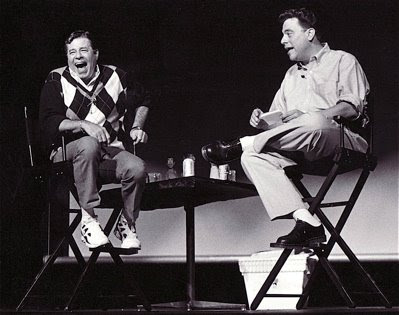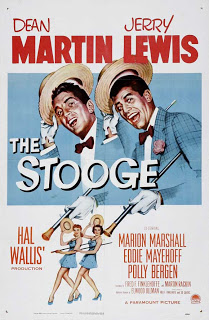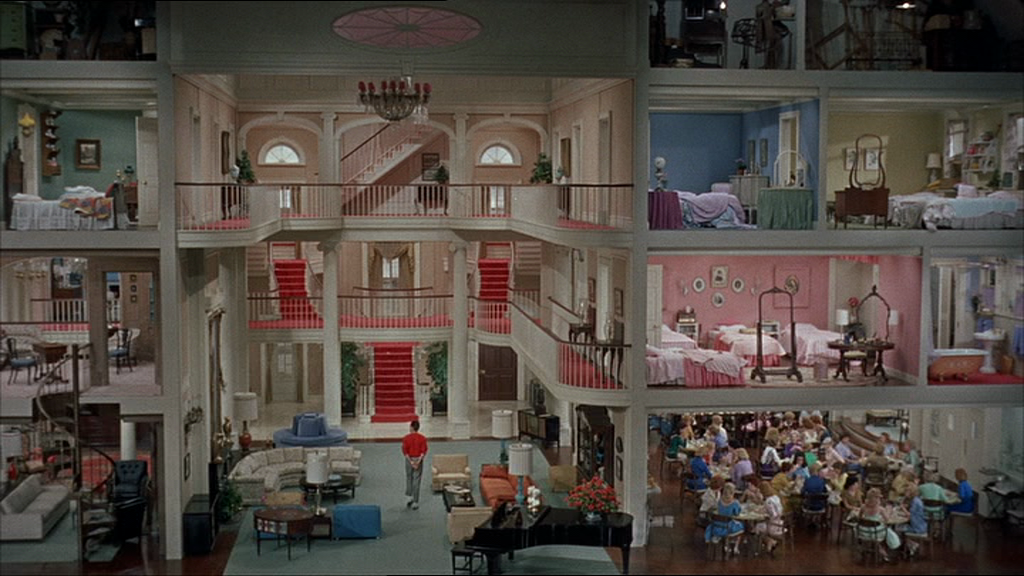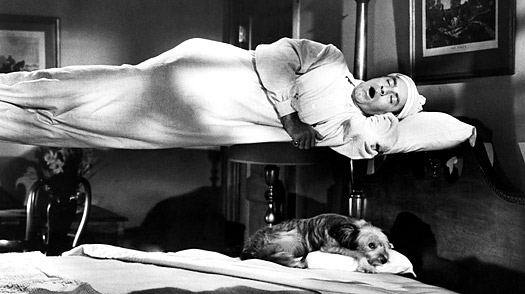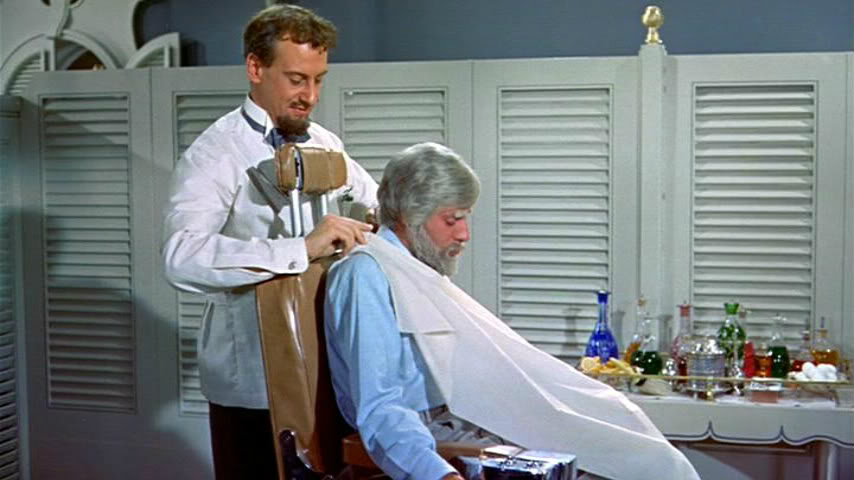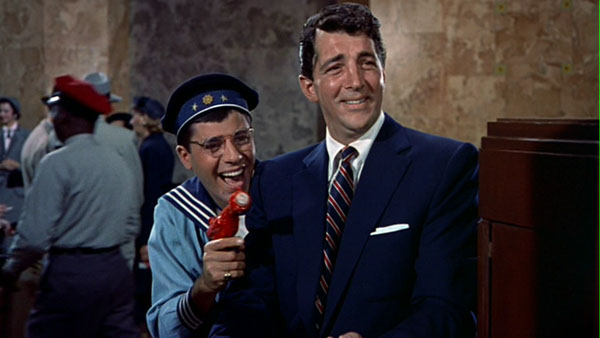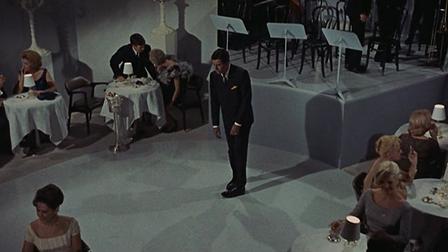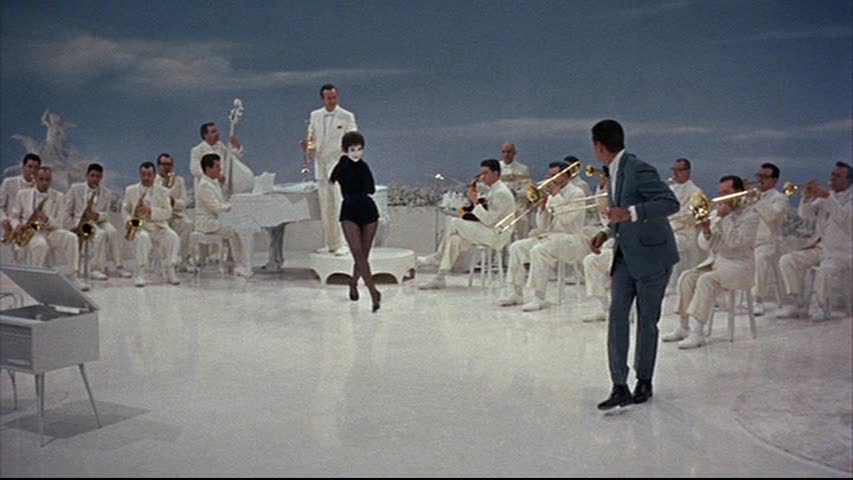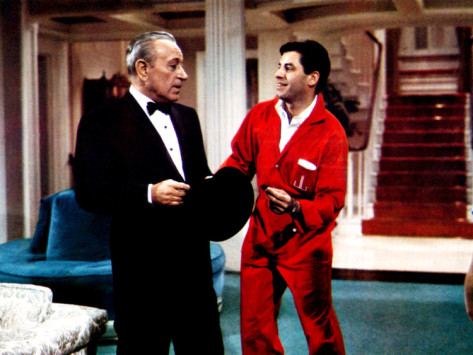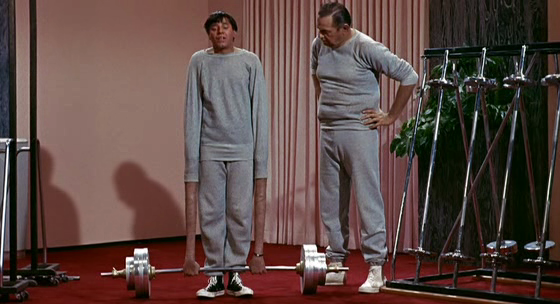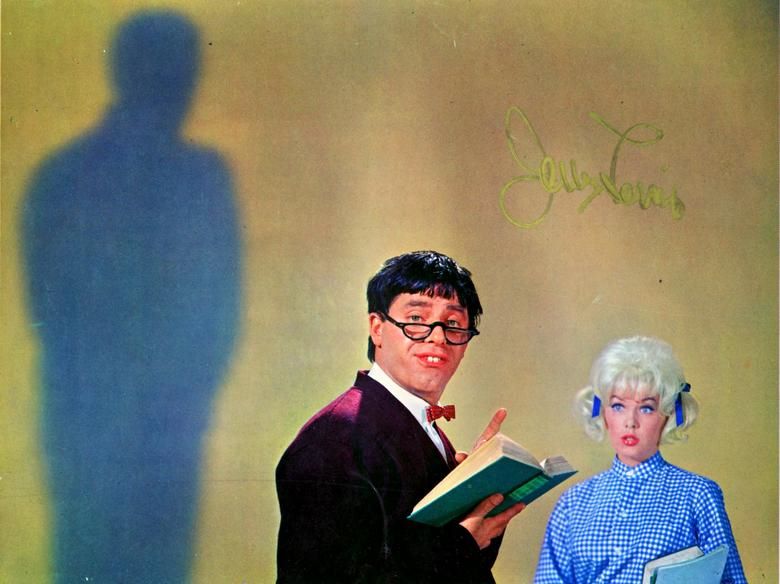Written for the Viennale’s catalogue accompanying its Jerry Lewis retrospective in October 2013, where it appears in German translation. — J.R.
1. Why Did — and Do — the Americans Love Jerry Lewis So Much?
…Jerry Lewis’s face, where the height of artifice blends at times with the nobility of true documentary. — Jean-Luc Godard on Hollywood or Bust, July 1957 (1)
The usual question — and by now a completely tiresome one — is, “Why do the French love Jerry Lewis so much?” People have been asking this question — mainly rhetorically rather than with any genuine curiosity about the answer — for over half a century, yet if it was ever worth asking in the first place, this was only for roughly the first two decades of that period. As far as I can tell, this was a love that was first fully declared in detail (though it was far from being universally accepted even in France, then or later) in December 1957, when Robert Benayoun published an article in Positif entitled “Simple Simon ou l’anti-James Dean”, although earlier appreciations, Godard’s among them, had already appeared by then.
This was only about a month before Lewis, having ended his partnership with Dean Martin a year and a half earlier, and subsequently become his own producer on Rock-a-Bye Baby, purchased a mansion in Bel Air that had formerly been owned by the late Louis B. Mayer, containing over thirty rooms, seventeen bathrooms, and three kitchens. And it seems fairly obvious that most of the money that paid for this lavish spread came from the love of Lewis’s fellow Americans, not from any love of “the French”.
Indeed, it becomes far too easy for us to forget that an estimated 80 million people saw Sailor Beware (1951), Martin and Lewis’s fourth feature, and that their ninth, Living It Up (1953), another one of their best, made more money than Singin’ in the Rain, On the Waterfront, or The African Queen. Indeed, the fact that the monster impact of Martin and Lewis on American society of the 1950s briefly preceded that of Elvis Presley suggests that, in their own manic fashion, Dean and Jerry helped to usher in the youth culture of the 1950s and its own liberating physical impulses (associated mainly with sex, drugs, and rock ‘n’ roll) in which Lewis’s body spoke louder than his words (which often took the form of gibberish anyway) and seemed to have an erupting and convulsive will of its own, cutting through all the multiple restraints that characterized American society during this period. (See, in particular, the extraordinary and singular dances performed by Lewis in such films as Sailor Beware, Living It Up, You’re Never Too Young [1954], Cinderfella [1959], The Ladies Man [1961], and The Nutty Professor [1962].)Despite the fact that Lewis was saddled with a producer at Paramount, Hal B. Wallis, determined to keep his and Martin’s comedies as innocuous and as formulaic as possible — a service Wallis provided even more ruinously to Elvis Presley a little later by similarly and systematically de-radicalizing and dry-cleaning his star’s image and appeal in relation to sex, ethnicity, race, and politics — Lewis, unlike Presley, gradually acquired enough clout to exercise creative control as writer, producer, and director, even though he initially received no screen credit for this. Wallis fully succeeded, however, in depriving Lewis of any of the cultural prestige that he routinely assigned to his adaptations of Broadway dramas during the same period — many of these about frustrated middle-aged woman (e.g., Come Back, Little Sheba, The Rose Tattoo, The Rainmaker, Summer and Smoke) — and sometimes being rewarded for his good middlebrow taste with Oscars. For Wallis and his constituency, “art” usually meant the legitimate stage (especially Tennessee Williams), literature, and/or foreign actors such as Anna Magnani and Anthony Quinn — lessons that Woody Allen would benefit from (as would Arthur Penn, Francis Coppola, Martin Scorsese, among other culturally ambitious American directors) when he openly emulated European filmmakers and “serious” American playwrights, something Lewis has never done. (The only time when Wallis brought Lewis and his “higher” cultural aspirations together, it was the latter that clearly suffered, in a 1959 adaptation of Gore Vidal’s Visit to a Small Planet.) Obviously, a large part of this cultural prestige had to do with targeting films for adults rather than children; to the extent that Lewis continued to regard his core audience as kids, lack of cultural stature was a given — as it was for the Elvis Presley films, pitched to a somewhat older but still non-adult public.
In fact, the alleged “French love” of Jerry Lewis has always really been a matter of highbrow prestige rather than one of either demographics or business. There are of course other occasions in film history when misunderstandings emerge from mainstream artists exhibiting some of the traits and temperaments of avant-garde artists: think of Chaplin, Stroheim, Val Lewton, Kubrick, Elaine May. But it’s hard to think of anyone else apart from Lewis in which there’s such a huge disparity between his or her mainstream and avant-garde profiles.
The distaste for Lewis expressed by many of his fellow Americans is largely a matter of rejecting what might be regarded as his excesses: lowbrow mugging, extreme physicality, infantile behavior, and recourses to sentimentality, in contrast to the dry and cerebral middlebrow and “grownup” comedy of Woody Allen.But considering the degree to which both tolerance and celebration of various kinds of excess define the American character, above all in cinema — so that mass slaughter is often regarded as a fit subject for family entertainment, and serial killers in such films as The Silence of the Lambs and No Country for Old Men are even perceived with a certain reverential awe as holy figures — it’s worth asking why the excessive clowning and destructive consequences of an adult behaving like an out-of-control nine-year-old might be the cause for so much repulsion and recoil. Clearly other factors come into play.
There are striking class differences in the contrasting performance and directorial styles of Lewis and Allen as well: regardless of how many rooms his Bel-Air mansion had, Lewis’s nouveau riche manner, like that of Elvis, kept his persona firmly within the realm of the working-class (apart from a few strained exceptions, such as his early role in That’s My Boy), and not at all ashamed or embarrassed to be there, whereas the class anxieties in Allen’s comedies and dramas, as clarified especially in his recent Blue Jasmine, are entirely predicated on upscale privileges or their absence — often trumping and in effect replacing the various cultural and social anxieties that they appear to be about. (A rare and noble exception to this tendency is Broadway Danny Rose.) So even though it’s worth bearing in mind that Woody Allen, a Lewis fan himself, asked Lewis to direct his first feature, Take the Money and Run, before deciding to direct it himself, the ideological differences between his comic persona and Lewis’s remain profound.
So if a question that might have some pertinence for the mid-1950s through the mid-1970s, “Why do the French love Jerry Lewis”, can be superseded by a question pertinent to the next four decades, “Why do the French and the Americans love Woody Allen?”, the fact that the first question continues to get posed while the second question doesn’t isn’t because an answer to either question is self-evident. Perhaps even more to the point, why do the Americans love and hate Jerry Lewis? Clearly the degree to which he challenges, provokes, embarrasses, and sometimes even scares and troubles his public already sets him apart from Allen, Chaplin, Keaton, Lloyd, Langdon, and Tati, arguably placing his work closer to that of someone like Poe than to most other comics — though far removed from Poe’s representational strategies or his sense of narrative continuity in its obsessive, nightmarish intensity. This intensity both reflects and solicits a sort of passionate ambivalence that could be traced back to Lewis’s show-biz parents, who failed to show up for their only son’s bar mitzvah and left most of their parenting chores to grandparents and an aunt. The begging and pleading for attention that soon became part of Lewis’s performing style were clearly a response to a feeling of abandonment and to the panicky emotional hunger it fostered — an aesthetics of excess predicated on the assumption that even too much could never be enough.
If the Americans hadn’t loved Jerry Lewis as much as they did between 1950 and the mid-1960s — so much that he wound up making two or three profitable features a year — it seems unlikely that the French would have “discovered” him. The ferocious Anglo-American backlash that has ensued ever since is a far more interesting phenomenon than any presumed overestimation by “the French”, already made somewhat dubious by Lewis’s own avowal that he’s been even more popular in other parts of the world. And it seems likely that the degree to which Lewis’s persona has come to embody “America” for many people around the world helps to explain part of this backlash. In fact, French critics were the first to note the importance of Lewis’ character in Which Way to the Front? [1970] — the richest man in the world, rejected by the draft and assembling his own army of misfits to win World War 2 — being named Byers, a pun for “buyers”. (Byers’ surreal and traumatized deformations of language brought about by references to him being “rejected”, almost incantatory forms of unbridled babbling, are arguably even funnier than his physical deformations.) Exploring what attracted her to Lewis’s movies in both pre-revolutionary and post-revolutionary Iran, Mehrnaz Saeed-Vafa in her 2012 essay film Jerry and Me never explicitly links his films to political freedom, but she repeatedly associates him and his movies to America and all that it signified for her as a child, which includes the freedom to be nonsensical and irresponsible.
2. The Lewis Conundrum
Lewis’s films constantly put in question their own implied underlying meanings. Because the context he sets up is basically a show-business context — in which persons and their meanings are always constantly performed — the possibility always exists for a second- (or a third-, or a fourth-) degree reading of meanings as simulated or disavowed. — Chris Fujiwara, Jerry Lewis (2)
In certain respects, auteurist criticism has distorted and confused Lewis’s achievements more than clarified them, by unduly privileging Frank Tashlin (3), a major and misunderstood figure in his own right (though one tied much more to social and cultural satire than to Lewis’s more metaphysically unstable form of self-scrutiny), by oversimplifying the intricate collaborative nature of Lewis’s partnership with Tashlin in such films as Rock-a-bye Baby (1958) and Cinderfella, and, above all, by privileging direction over performance and writing, which are always at the center of Lewis’s art. (This is why I can’t regard the 1970 One More Time, which Lewis neither wrote nor instigated as a project, as a “Jerry Lewis” film in the way that A Woman of Paris and A Countess from Hong Kong are Charlie Chaplin films.) The overall unity of Lewis’s films as a performer regardless of who directed them -– so that, for instance, some of the traits of Irma and Jane in the two My Friend Irma films (1949-50) are echoed in the characters of Shirley MacLaine and Dorothy Malone in Artists and Models (1955) –- begins to suggest some of drawbacks in viewing Lewis simply as a director. Even in his work as solo director, privileging mise en scène over découpage doesn’t do justice to the full extent of his filmmaking. (One of Lewis’s favorite stories, recounted in the chapter about editing in The Total Film-Maker [4], describes the crucial difference made by cutting only two frames from a shot in The Bellboy in order to make a particular gag work — a gag he would restage 21 years later in Hardly Working.) Lewis’s desire to resurrect the title hero of The Nutty Professor in both The Family Jewels (1965) and The Big Mouth (1967) clearly exceeds any narrative or stylistic function they might have in what is already an absurdist universe profoundly out of joint, both metaphysically and morally. To perform, existentially speaking, means in effect and at best to forge temporary meaning in a nihilist void, soon to be supplanted by other temporary meanings.
It could be argued that all comics deal with different forms of anxiety. Woody Allen’s aforementioned class anxiety should be juxtaposed with the relative acceptance of Lewis’s heroes being either working-class or nouveau riche, where social maladjustment is only incidentally a matter of failing to meet the norms of middle-class conformity. This suggests in Lewis’s case a form of pride and freedom harking back to his formation during the Depression, in contrast to Allen’s formation nine years later, where “rising above” one’s class origins — epitomized in his case by the move from Brooklyn to Manhattan — becomes the major aspiration. Lewis, by contrast, has proudly remained someone from New Jersey to the same degree that Frank Sinatra did throughout his own career. So it isn’t surprising that in The Caddy (1953), the golfing careers of Martin and Lewis’s working-class characters, recounted in flashback before they became a rich show-biz team exactly like themselves, derives most of their comic tension from their awkward entanglements with the country-club set, culminating in literal class warfare at a climactic tournament.
To revert to an ethnic stereotype, Lewis and Allen both project the personas of “pushy” (i.e., aggressive) Jews, but in very different ways — modified in Lewis’s case by a certain meekness that overtakes his own character once pathos becomes an important part of his image (which starts as early as That’s My Boy in 1951). Prior to that, we find, in Lewis’s first two film appearances — in My Friend Irma (1949) and My Friend Irma Goes West (1950), where he and Dean Martin both receive second billing — a persona noticeably different in some respects from the one that would develop later.
My Friend Irma, the movie spinoff of a popular radio show — one that I listened to with some regularity as a toddler before seeing the My Friend Irma films — focuses on two young women sharing an apartment in Manhattan and both usually working as secretaries, a level-headed brunette narrator named Jane (Diana Lynn) and her dizzy and dumb-blonde pal Irma (Marie Wilson), similar in some respects to the duo in My Sister Eileen. When Hal Wallis at Paramount successfully outbid his Hollywood studio rivals to sign a contract with Martin and Lewis — by then the hottest act in American show business (thanks to nightclub gigs, their own radio show, appearances on television variety shows, and even a single that they recorded at Capitol Records), after teaming up in 1946 — he decided to cast Martin as Jane’s boyfriend, Steve, which required only minor adjustments to the radio show by making Steve an aspiring singer. But when it came to casting Lewis as Marie’s boyfriend — a sleazy con-artist named Al who resembled a Damon Runyon character and tended to live off of Marie’s income — the results of a screen test proved disastrous, and a hasty meeting with writer Cy Howard yielded a new character for Lewis named Seymour, Steve’s partner in running an orange juice stand, and a decision to cast actor John Lund as Al.
One consequence of this rapid switchover is that some of Seymour’s qualities (innocence, goofiness, a capacity to wreak chaos) seem like carryovers from Irma while certain others (abrasiveness, urban aggression, a tendency to whine and complain) suggest a few leftover traits from Al. And some of both can be related to Lewis’s own personality. (From page 174 in Jerry Lewis in Person [5], circa the early 1950s: “Many a night I’d get into my XKE Jaguar and speed down Sunset Boulevard, blasting the horn for no particular reason except to feel monumentally important.”) And the standard practice of doubling characters in comedy seems to have led to Steve exploiting Seymour at work (it’s Seymour who does all the physical orange-squeezing) to “rhyme” with Al exploiting Irma. As suggested above, it isn’t until pathos and sentimentality become more integral to Lewis’s persona that the sleazier aspects start to become minimized — even though Lewis has become sufficiently comfortable with Seymour in My Friend Irma Go West (a considerable improvement over its predecessor) to create some of his freest inventions, e.g., a lengthy sequence featuring him with a chimpanzee on a cross-country train journey, which playwright George S. Kaufman reportedly acclaimed as the funniest thing he’d ever seen in a movie. But this isn’t to say that major contradictions in Lewis’s persona don’t persist, all the way up to the present.
3. Chance and Spontaneity
Show business constitutes, for Lewis, an alternate psychoanalysis, a therapeutic sphere in which he acts out his obsessions in public and transcends them (see the confession scene in the prom in The Nutty Professor). In several films, Lewis depicts show business as an alternate family. — Chris Fujiwara, Jerry Lewis (6)
One shouldn’t assume that Jerry Lewis’ first encounter with cinema in 1949 came out of nowhere. It came, specifically, out of live performance — first in nightclubs, and then on radio and television. It was live performances with Dean Martin (even when these were simulated and/or prerecorded on television while conveying the same improvisatory spirit that was part of the medium during that period) that made them stars before they went to Hollywood, and it’s worth considering what special ingredients they brought to those appearances, which above all were a matter of spontaneity and the unexpected — a genuine sense of anarchy erupting during one of the most repressive periods in American history,
Indeed, one way of reading all their early features is to see them as mechanisms striving to approximate the same energies and freedom that brought them to Hollywood in the first place. Typically, a “straight” performance of a song by Martin gets repeatedly interrupted, disrupted, and deconstructed by Lewis’s antics — a routine depending on the improvisational talent of Martin as well as Lewis — and variations of this routine turn up in virtually all these features, most often in nightclub or other live-performance settings. Paradoxically, such routines always required some preparation and even rehearsal, even when various improvisations provided additional sparks to the combustion of their chemistry, but the relative invisibility of these designs to the public kept the performances volatile, conveying the impression that “anything” could happen.
The fact that in many of his routines on the Colgate Comedy Hour, Lewis can be seen interrupting himself to laugh uncontrollably at his own jokes might seem the height of undisciplined show-biz behavior, but it also suggests both a complicity with the audience — he never laughs alone — and the impulse to deconstruct and even demolish the fictional “givens” of any particular sketch, including those that he might have dreamed up himself, a kind of perpetual auto-destruction that becomes an essential part of his filmmaking as he steadily gains more control over the writing and direction of his features.
One interesting parallel of Lewis with Charlie Chaplin is that they both had parents who were live performers, and both had their stage debuts performing a popular song at age five because of their family connection. In Chaplin’s case, as recounted by his best biographer (7), the song was “Jack Jones,” and the five-year-old replaced his mother after her voice cracked and fell into a whisper. (In his Autobiography, Chaplin wrote, “That night was my first appearance on the stage and Mother’s last.”) When a “shower of money” was thrown at the boy during his singing, he stopped and “announced that [he] would pick up the money first and sing afterward,” which “caused much laughter” that only increased when the stage manager helped him collect the money, and then increased again when he wound up imitating his mother’s cracked voice during another song.
Lewis’s stage debut occurred at a benefit for the Firemen’s Association held at a hotel in the Catskills. Like many others during this period, his father had been performing the Depression standby, “Brother, Can You Spare a Dime?,” as part of his act, and at his son’s urging, he allowed him to be brought onstage for an encore, after much rehearsing with his mother, who provided piano accompaniment. As Lewis remembered it later, while taking his bow, his foot slipped and caused one of the footlights to explode; “it scared me half to death,” the audience laughed at his panic, and, as he put it in an interview on the Arts & Entertainment Network, “and I liked the laugh I got better than the applause I got.” (8)
In both cases, one could say that the very first lesson learned, helping to set the terms for future performances, came from the audience. In Lewis’s case, this lesson becomes complicated initially by the presence of his partner (so that Dean Martin himself, who was nine years older, becomes both part of the audience and an audience surrogate as well as a co-conspirator — an “older brother” providing a sort of life raft to the seeming lack of control), and then, after the breakup of his partnership, with a kind of solipsistic self-scrutiny and self-interrogation once Lewis becomes a solo performer and the films become much stranger and, as a rule, less concerned with issues of narrative coherence. There’s even less concern with verisimilitude in relation to period; Which Way to the Front?, opening in 1943 Manhattan, alludes to “condominiums” in its first scene at least fifteen years before the first one existed. The same comic who would eventually build elaborate gag sequences in Cracking Up (1983) derived from his near-brush with a suicide attempt, the pain experienced from his surgery, and his attempts to stop smoking has in fact based most of his features on some of his most personal conflicts, issues, and wounds. Part of what’s disconcerting about his preceding Hardly Working — his least Hollywoodish feature, made after over a decade’s absence from the screen — is its painful honesty about Lewis’s aging and loss of stamina (which even becomes the point of certain gags, such as Bo Hooper’s fantasy of being John Travolta in Saturday Night Fever) and the stark division of all the other characters into kids and adults who either love Bo and laugh at his every grimace or simply despise him; no one is allowed to be neutral.
As Fujiwara persuasively notes, show business serves for Lewis as both an alternate psychoanalysis and an alternate family — even though one should note that standard psychoanalysis isn’t taken very seriously in either Three on a Couch or Cracking Up. But considering the degree to which Lewis’s identity (which includes his life and family) are hard to separate from show business, a certain auto-critique that at times verges on self-loathing typically extends to show business itself and everything it entails, as in The Errand Boy and The Patsy. This self-hatred achieves its purest expression in The Nutty Professor’s Buddy Love, who is show business personified — and even to a lesser extent Lewis’s title hero and Love’s apparent opposite, Julius Kelp, who traces his own ineptitude directly back to his monstrous parents. (Part of the grimness of this film’s “happy ending” is its suggestion that everyone ultimately prefers the brutal egotist to the meek professor; even the sweet-tempered heroine [Stella Stevens] packs two bottles of the secret formula on her way to the altar.) One reason why Lewis’s performance in Martin Scorsese and Paul D. Zimmerman’s The King of Comedy (1982) resonates as strongly as it does is that it conforms to the impression that being a big-shot celebrity effectively means being a monster (and also sometimes having contempt for one’s parents, as Robert De Niro’s Rupert Pupkin does in his climactic comedy monologue), and perhaps even Lewis’s telethons for muscular dystrophy can be viewed as a long-standing effort to compensate for this sort of troubling moral intuition.
Several years ago, when he was appearing onstage as the Devil in Damn Yankees during its Chicago run, he graciously agreed to appear at an extended public discussion at nearby Columbia College — a session that lasted, if memory serves, for at least three hours. The sense of risk and danger in the auditorium that afternoon was palpable, and it came, I think, from the fact that Lewis stayed so close to the edge of his emotions, seemingly as a matter of both policy and temperament. The possibilities of being hurt, and of hurt being transformed into anger and rage, were never entirely absent, even though he managed to keep his cool on the few occasions when one of the questions betrayed some hostility — hostility that may have derived in part from some of the tension generated. (The absence of such tension and any feeling of danger in the work of Woody Allen is no less striking.)
4. The Lewis Contradiction
There are two basic kinds of clown. In the classic circus, there’s the clown who is white-faced, with a white cap, short trousers, and silk stockings. He has beautiful legs, and is very elegant. Every move he makes is perfect. The other clown, who works with him, is called an auguste, and he has baggy pants and big feet. What Chaplin did was to marry them, these two classic clowns, and create a new clown. That was his secret — that’s my theory. — Orson Welles, My Lunches with Orson: Conversations Between Henry Jaglom and Orson Welles (9)
“I love persons and people.”
“Persons and people. There’s a difference?”
“Oh, sure. There’s a big difference. You see, persons…persons are people who have made it, who are rich and famous. So that, of course, makes them persons and they’re not people anymore.”
— Fella (Lewis) to his Fairy Godfather (Ed Wynn) in Cinderfella (1959)
In The Stooge (1953), set in 1930, Lewis plays Ted Rogers, a hapless and clueless song-plugger (the one-time profession of Lewis’s father) who gets hired by singer Bill Miller (Martin) at the insistence of his manager (Eddie Mayehoff) to beef up Miller’s unsuccessful single act, using Rogers as a stooge who interrupts the singer’s performance from a box seat. According to the plot, these interruptions are spontaneous and innocent, and Rogers doesn’t even object when Miller refuses to give him any billing after the act is a smash success. Yet one night, when Miller is too drunk to go on and Rogers has to replace him as a single, he proceeds to imitate Maurice Chevalier singing “Louise”.
Considering who the character is, this performance makes no sense at all; it’s not even very credible that Rogers would know who Chevalier is, much less be able to perform a carefully rehearsed and meticulous pastiche of his singing style and mannerisms without any preparation. But one can fully understand Lewis calling The Stooge his best work with Martin, “because it transferred two nightclub performers to the screen properly. It came closest to capturing what Dean and I had as a team” (10) And it epitomizes the degree to which Lewis’s character is founded on a contradiction as profound as the merging of two antithetical clowns in Chaplin’s persona as described by Welles — or as Marilyn Monroe’s Lorelei Lee in Gentlemen Prefer Blondes being simultaneously a very dumb blonde and a brilliantly conniving schemer.
It’s a kind of contradiction that superstars are born to embody without the audience ever noticing it — unless one notices, for example, such details as Bo Hooper (Lewis), an out-of-work clown in Hardly Working, wearing the same expensive jewelry that Lewis habitually wears. For Lewis’s persona is at once powerless and omnipotent, awkward and graceful, clueless and sophisticated, a snappy dresser (even as a misfit) as well as a slob, and these contradictions necessarily encompass other contradictions as well. The giddy megalomania of the man who spread his remarkably lavish boarding-house set over two of Paramount’s soundstages in The Ladies Man (1961) and then filled them with nubile young actresses is difficult to reconcile with the fumbling idiot and the sexual panic of Lewis’ own persona within that constructed space (who literally splits into four versions of himself when he sees all these women for the first time and flees from them), but ongoing disparities of this kind are fundamental to Lewis’s art and the dream logic of his inventions. (It’s worth adding that Lewis’s major contribution as a technical pioneer — his invention of the video assist, introduced on The Bellboy [1960], his first feature — was motivated specifically by a desire to act and direct at the same time.) Even in Visit to a Small Planet, Lewis’s hapless extraterrestrial character having telepathic and telekinetic powers doesn’t seriously threaten the essential nature of his persona. The fact that, in some of his earliest recorded appearances with Martin, Lewis both cavorts like a spastic marionette and can be seen confidently conducting orchestras only begins to account for the duality he embodies and suggests, equally apparent in his pantomimes tied to music (the earliest form taken by his live comic performances). Yet the ideological safety net provided to virtually all his fictional characters is a perpetual yearning to conform to the status quo without challenging any of its basic principles. Typically, Fella in Cinderfella and Julius Kelp in The Nutty Professor are both apparently content to remain abject failures as “people” without ever questioning the successes of such “persons” as Fella’s odious stepmother and stepbrothers or the equally obnoxious Buddy Love. Like Shakespeare’s Cassius, these characters all seem to conclude, “The fault, dear Brutus, is not in our stars, /But in ourselves, that we are underlings.”
In some films, the Lewis persona isn’t simply contradictory but infinitely malleable, to the point of incoherence. On dance floors, even the withdrawn and graceless “Junior” Jackson in That’s My Boy and Julius Kelp are compelled to break briefly into Lewis’s gracefully jagged jitterbugging. In You’re Never Too Young, Wilbur Hoolick runs the gamut from inept barber’s assistant (when he first appears and in the film’s closing gag) to two separate fake Frenchmen (one of them ancient) to an alternately bratty and sweet-tempered 11-year-old to a conniving competitor for the affection of the heroine (Diana Lynn), plotting to get Bob Miles (Martin) shipped overseas in the army by perfectly imitating the voice of his boss’s daughter (Nina Foch) over the phone; he also oscillates periodically between being fearless and terrified, and also offers a sustained Humphrey Bogart impersonation in one scene.
At least theoretically, one can subdivide not only Lewis but most of his pictures as writer-director-performer into two pairs of templates, best represented by his masterpieces The Ladies Man and The Nutty Professor: (a) nonlinear collections of gags versus linear narratives with beginnings, middles, and ends, and (b) free-form conceptual fantasies versus fictions grounded in some form of social commentary. But in practice, these features rarely opt for one or the other. Even the more nonlinear films (ranging from The Bellboy to the even more discontinuous Cracking Up), where narrative continuity is mostly perfunctory, are furnished with narrative setups and/or resolutions, and even some with more developed stories, such as Three on a Couch, have nonlinear interludes (e.g., the remarkable and peculiar “slow dance” sequence with Janet Leigh) and brightly expressionist color schemes. (In the latter film, Lewis, for once, plays an “adjusted” adult, but the three men his character chooses to impersonate are even more maladjusted than Lewis’s usual misfits, while the story’s relatively “realistic” framework gets periodically jettisoned for fantasy gags that seem to belong to a different picture.) The Ladies Man is mainly a string of fantasies where anything can happen, but when a TV crew turns up at the boarding house to shoot a live show (a parody of Edward R. Murrow’s Person to Person), the details become relatively realistic, as they do in many of the film-production details in The Errand Boy. Furthermore, the social commentaries often become abstracted into subjective fancies — one forbidden room in The Ladies Man becomes an all-white bedroom and then an open-air arena where Lewis dances with a predatory female in black to Harry James’ orchestra; an offscreen pet that roars proves to be first a dachshund, then an actual lion — so that the usual distinctions between external and internal visions are systematically dissolved.
Lewis’s first two features, The Bellboy and The Ladies Man, are set in very different kinds of hotels — the Fontainbleau in Miami, filmed on location, and an improbable boarding house for young women, constructed on Paramount soundstages — and are mainly nonlinear fantasies in which, speaking very broadly, each room provides a separate cell or sequence, and the third, The Errand Boy, expands this overall concept to a movie studio, where sets and locations seem interchangeable. At one point in The Bellboy, Lewis appears as himself entering the Fontainbleau, surrounded by a satirically huge entourage, and one sequence in The Ladies Man, also set in a common public space, is inspired by Lewis’s knowledge of George Raft’s early career as a dancer and features George Raft playing himself (though it’s predicated on Lewis’s fictional character refusing to believe that Raft is Raft or that he had any background as a dancer).
In The Errand Boy, immediately after Lewis’s character has a fantasy dialogue with a puppet named Magnolia that defends Hollywood’s power to successfully sustain illusions (a scene in which Lewis’s personal background as a moviegoer in New Jersey plays a part), he cuts to a very hokey dramatic death scene that is belatedly shown to be a movie scene being filmed (as if to undermine the preceding argument — a contradiction already propounded more systematically in the film’s prologue, showing how various archetypal movie scenes are faked); and the film concludes with a variation of its opening gag juxtaposing Lewis himself with his hapless character Morty Tashman, who’s clearly named after Frank Tashlin. By the same token, Chris Fujiwara has persuasively shown that for virtually every sentimental and conformist detail in Lewis’s own films, one can find other details ridiculing or otherwise disavowing sentimentality and/or conformity: “Lewis’s parodic impulse takes the form of a sententiousness that not only has no fear of parodying itself but doesn’t even worry whether the parody is understood as parody: ambiguity is ever-present in Lewis, at least as a threat.” (11)
Given Lewis’s biography, it isn’t surprising that most of his social commentaries relate directly or indirectly to show business and/or psychological self-scrutiny, and a good many of these partly consist of shattering whatever illusions the films and their stories and characters have been busy constructing. Combining the height of artifice with the nobility of documentary, as Godard put it, Lewis’s face, like his cinema, is a calculated yet spontaneous contradiction of terms — suggesting the metaphor Godard once used to describe his own Pierrot le fou of a bathtub being filled by water and draining at the same time. So it’s small wonder that contemporary mainstream criticism should find the more verbally based and rational comedies and dramas of Woody Allen more comfortable and digestible, especially in comparison to Lewis’s brand of performative slapstick, where the universe itself remains profoundly and perpetually but also routinely devoid of purpose or meaning.
***
End Notes
1. Godard on Godard, translated and edited by Tom Milne, New York: Da Capo, 1986, p. 59.
2. Urbana/Chicago: University of Illinois Press, 2009, p. 48.
3. As Robert Benayoun points out in Bonjour Monsieur Lewis (Paris: Eric Losfeld, 1972, p. 240), Living It Up and You’re Never Too Young (1955), both directed by Norman Taurog, can hold their own with Tashlin’s Artists and Models (1955) and Hollywood or Bust (1956); indeed, all four of these films have their peaks and valleys.
4. New York: Warner Paperback Library, 1971, pp. 128-129.
5. Lewis, Jerry, with Herb Gluck, Jerry Lewis in Person, New York: Atheneum, 1982, p. 174.
6. Op. cit., p. 57.
7. Weissman, Stephen, M.D., in Chaplin: A Life, New York: Arcade Publishing, 2008, pp.27-28.
8. Jerry Lewis: The Last American Clown, broadcast 18 August 1996.
9. Peter Biskind, ed., New York: Metropolitan Books, 2013, p. 146.
10. The Jerry Lewis Films: An Analytical Filmography of the Innovative Comic, by James L. Neibaur and Ted Okuda, Jefferson, NC/London: McFarland & Company, 1995, p. 61.
11. Op. cit., p. 45. See also pp. 33 & 46-49.

